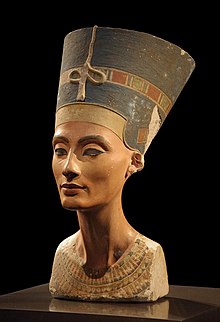Queen Nefertiti
| Nefertiti | |||||
|---|---|---|---|---|---|

|
|||||
| Queen consort of Egypt | |||||
| Tenure | 1353–1336 BC or 1351–1334 BC |
||||
| Born | ca. 1370 BC | ||||
| Died | ca. 1330 BC | ||||
| Spouse | Akhenaten | ||||
| Issue |
Meritaten Meketaten Ankhesenamun Neferneferuaten Tasherit Neferneferure Setepenre |
||||
|
|||||
| Dynasty | 18th of Egypt | ||||
| Father | Ay (possibly) | ||||
| Religion | Ancient Egyptian religion | ||||
| Full name | |
|---|---|
| Neferneferuaten Nefertiti |
| Neferneferuaten-Nefertiti in hieroglyphs | ||||||||||||||
|---|---|---|---|---|---|---|---|---|---|---|---|---|---|---|
Neferneferuaten Nefertiti Nfr nfrw itn Nfr.t jy.tj Beautiful are the Beauties of Aten, the Beautiful one has come |
||||||||||||||
Neferneferuaten Nefertiti (/ˌnɛfərˈtiːti/) (ca. 1370 – ca. 1330 BC) was an Egyptian queen and the Great Royal Wife (chief consort) of Akhenaten, an Egyptian Pharaoh. Nefertiti and her husband were known for a religious revolution, in which they worshiped one god only, Aten, or the sun disc. Together Akhenaten and Nefertiti were responsible for the creation of a whole new monotheistic religion which changed the ways of religion within Egypt. With her husband, she reigned at what was arguably the wealthiest period of Ancient Egyptian history. Some scholars believe that Nefertiti ruled briefly as Neferneferuaten after her husband's death and before the accession of Tutankhamun, although this identification is a matter of ongoing debate.
Nefertiti had many titles including Hereditary Princess (iryt-p`t); Great of Praises (wrt-hzwt); Lady of Grace (nbt-im3t), Sweet of Love (bnrt-mrwt); Lady of The Two Lands (nbt-t3wy); Main King's Wife, his beloved (hmt-niswt-‘3t meryt.f); Great King's Wife, his beloved (hmt-niswt-wrt meryt.f), Lady of all Women (hnwt-hmwt-nbwt); and Mistress of Upper and Lower Egypt (hnwt-Shm’w-mhw).
She was made famous by her bust, now in Berlin's Neues Museum, shown to the right. The bust is one of the most copied works of ancient Egypt. It was attributed to the sculptor Thutmose, and it was found in his workshop. The bust is notable for exemplifying the understanding Ancient Egyptians had regarding realistic facial proportions.
...
Wikipedia
